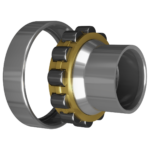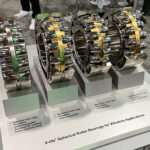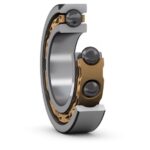 Rolling-element, anti-friction bearings, either ball- or roller-type, provide a mechanical means of countering radial and axial loads in rotating and reciprocating shafts. This article will briefly describe both types, then cite some examples where one type might be selected over the other.
Rolling-element, anti-friction bearings, either ball- or roller-type, provide a mechanical means of countering radial and axial loads in rotating and reciprocating shafts. This article will briefly describe both types, then cite some examples where one type might be selected over the other.
Ball Bearings
A typical ball bearing consists of inner and outer raceways, a number of spherical elements separated by a carrier, and, often, shields and/or seals designed to keep dirt out and grease in. When installed, the inner race is often lightly pressed onto a shaft and the outer race held in a housing. Designs are available for handling pure radial loads, pure axial (thrust) loads, and combined radial and axial loads.
Ball bearings are described as having point contact; that is, each ball contacts the race in a very small patch — a point, in theory. Bearings are designed such that the slight deformation the ball makes as it rolls into and out of the load zone does not exceed the yield point of the material; the unloaded ball springs back to its original shape. Ball bearings do not have infinite lives. Eventually, they fail from fatigue, spalling, or any number of other causes. They are designed on a statistical basis with a useful life where a certain number are expected to fail after a set number of revolutions.
Manufacturers offer single-row radial bearings in four series over a range of standard bore sizes. Angular contact bearings are designed to withstand axial loading in one direction and may be doubled up to handle thrust loading in two directions.
Shaft and bearing alignment play a critical role in bearing life. For higher misalignment capacity, self-aligning bearings are used.
To increase radial-load capacity, the bearing carrier is eliminated and the space between the races is filled with as many balls as will fit — the so-called full-complement bearing. Wear in these bearings is higher than those using carriers because of rubbing between adjoining rolling elements.
In critical applications where shaft runout is a concern—machine tool spindles, for instance—bearings may be preloaded to take up any clearance in the already tightly-toleranced bearing assembly.
Roller Bearings
Similarly constructed as ball bearings, roller bearings have line contact rather than point contact, enabling them greater capacity and higher shock resistance. The rollers themselves come in several shapes, namely, cylindrical, spherical, tapered, and needle. Cylindrical roller bearings manage only limited thrust loads. Spherical roller bearings can accommodate misalignment and more thrust, and, when doubled up, thrust in either direction. Tapered roller bearings can manage significant thrust loads. Needle bearings, a variant of cylindrical roller bearings, can handle high radial loads for their size, and can be made as needle roller thrust bearings.
Roller bearings are available as full-complement designs and needle bearings almost invariably will be of this style. Needle bearings are especially effective with reciprocating motions, but friction will be higher due to roller-against-roller rubbing.
When using cylindrical roller bearings on shafts with angular misalignment, it is preferred to use two short roller bearings back-to-back rather than one long roller bearing.
Choosing a Ball or Roller Bearing
As a general rule, ball bearings are used at higher speeds and lighter loads than are roller bearings. Roller bearings perform better under shock and impact loading.
Ball bearings are usually sold as assemblies and are simply replaced as units. Roller bearings can often be disassembled and the roller carrier and rollers, or the outer or inner races, replaced individually. Rear-wheel-drive cars use such arrangements for the front wheels. The advantage of this design is that the races can be shrunk fit onto shafts and into housings to create permanent assemblies without risking damage to the rollers themselves.
Single-row ball bearings are standardized and can be used interchangeably among manufacturers. Roller bearings are less-formally standardized so a specifier needs to consult a manufacturer’s catalog to select one appropriate for the application.
Rolling-element bearings are manufactured with a certain amount of internal clearance. Any misalignment that merely nudges a ball out of position and removes this internal clearance should not have much effect on the life of the bearing. Roller bearings are more sensitive to angular misalignment. For instance, a ball bearing running at moderate speed with a fairly loose fit might operate successfully with angular misalignment as high as 0.002 to 0.004 in./in. between the bearing and shaft. A cylindrical roller bearing, in comparison, might be in trouble if misalignment exceeded 0.001 in./in. Manufacturers will generally provide acceptable ranges of angular misalignment for their individual bearings.
Summary
This article presents a brief discussion of the differences between rolling-element bearings. For more information on additional products, consult our other blogs or visit our platform to locate potential sources of supply or view details on specific products.
RUWH
www.ruwhbearing.com/news/roller-bearings-vs-ball-bearings






